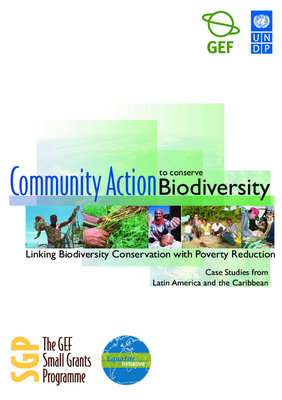Community Action to Conserve Biodiversity: Linking Biodiversity Conservation with Poverty Reduction

Author(s): GEF Small Grants Programme, Equator Initiative, UNDP
Publication Date: 2006
DOWNLOAD FILE
Key points in document
- The report describes community-based enterprises and the enabling conditions that are required for their success.
- Many community-based enterprises included are directed towards the triple bottom line of economic, social, and environmental outcomes.
- The report hosts 30 case studies from Central and South America. Though regionally focused, the lessons and feedback are valuable for community-based enterprises worldwide.
- The report is careful to point out that the “success” of a given project and enabling conditions that contributed to that success were largely synthesized from perceptions of community members consulted during field visits to these case study sites; therefore, the study does not provide a concrete definition of “success.”
- Lessons related to enabling conditions were split into two categories; internal and external.
- Analysis of the case studies suggest four categories of internal enabling conditions, including effective governance structures like strong community leadership and transparency, as well as equitable benefit sharing.
- The case studies highlighted the community’s relationships with the outside world as external enabling conditions. These conditions are characterized by access to capital and technical assistance (e.g., government-led technical trainings), and local or national partnerships (e.g., donors, NGOs).
Information relevant to Learning Questions:
Are enabling conditions in place to support a sustainable enterprise?
- Stakeholder alignment
- Market demand, access to credit/capital
- Ownership, governance
- Government requirements, policies for enterprises, business alliances
- Financial management capacity, technical capacity
- Equipment
- Benefit sharing, targeted participants, biodiversity linkage, policies for and enforcement of resource use
Does the enterprise lead to benefits to stakeholders?
- Increased income for participants
- Non-cash benefits
Do the benefits lead to positive changes in attitudes and behavior?
- Attitudes regarding sustainable use of resources
- Behaviors regarding sustainable use of resources
Does a change in stakeholders’ behaviors lead to a reduction to threats to biodiversity (or restoration)?
- Residential and commercial development
- Agriculture and aquaculture
- Energy production and mining
- Biological resource use
- Pollution
Does a reduction in threats (or restoration) lead to conservation?
- Forest ecosystems
- Freshwater ecosystems
- Grassland ecosystems
- Marine ecosystems
- Species

